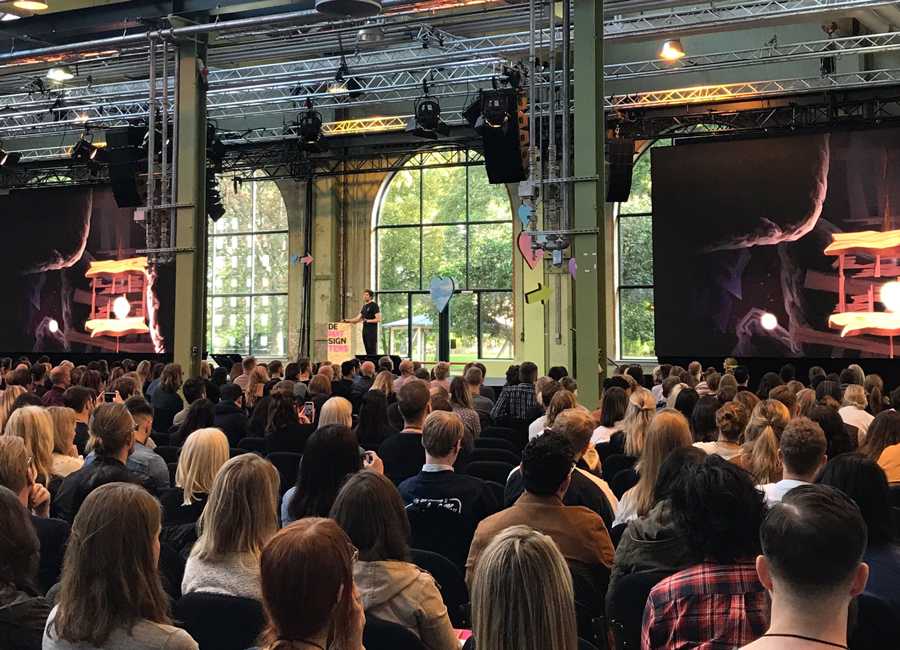
Are We on the Same Page? – Key Takeaways from the Design Matters Conference in Copenhagen
October 15, 2019
As designers, we play a fundamental role on how we approach today’s issues to create a bigger impact: Are we using technology to keep our focus on what matters and enforce our wellbeing? Are we using design to contribute to positive change? Are we appreciative of how working collaboratively help us deliver solutions more efficiently? These were some of the questions we were faced with on this year’s Design Matters conference in Copenhagen where we focused on discussions about design and our role when it comes to technology, activism and real time collaboration. During the two-day event we also had the opportunity to participate in workshops to learn more about Emotional Journey, Behavioral Science and Improvisation as tools to learn, adapt and overcome.
Screens are taking up too much of our time and attention with addictive functions. Most tech companies are prioritizing “addictive design” to form product habits. Speakers at the conference challenged us to create experiences that are less intrusive and that make us feel better instead, asking if we were designing for value or noise? On this theme, companies like Behance and Duolingo shared they are designing to focus on the importance of retention through empathy to give people back their time and value. Slack is helping us understand that to design experiences that result in user delight, it requires a deep understanding of communication, design and technology; and it’s because of it that we’ve seen the emergence of a new professional specialty: UX copywriter, helping to make actions intuitive and obvious. Meanwhile, Wetransfer brought our focus back to designing experiences that challenge our guidelines and to lead with principles.
Design is a powerful tool that can create awareness on difficult topics and give minorities a voice to contribute to a movement for positive change. Part of the challenge is to make a shift between designing from user-centric to a society-centric approach and finding design solutions that use as starting point our immediate surroundings and the limitations of the people we are designing for. As CIID’s interactive design lead Francesca Desmarais stated, there’s a big opportunity for designers to help people make sense of this new reality we live in and help them adjust their behaviour and lifestyle. Which is the case for Ushahidi, creating tools to help in crisis response, election monitoring, and humanitarian work by turning insights into specific design decisions.
Part of positive change is inclusivity and the role we all play in a future where we are no longer defined by our ethnicity and gender. How might we as designers contribute to breaking out of established patterns when it comes to digital voice assistants? That’s why Virtue, the creative agency by VICE, created Q – the world’s first genderless voice.
And lastly, we can’t talk about activism without asking ourselves, what can we do to make design more ethical? The only way to change the industry from within requires a culture of awareness and resistance.
Have you ever brainstormed or brought other people into your process and realize that having someone else perspective help you see other solutions that you didn’t see before? But, aren’t they most of the time, peers coming from the same academic background as you? Jenny Wen, product designer at Figma, challenged us with the concept of open design to recognize the value of other people’s ideas and contributions, challenging our internal assumptions. Open design means trusting the people in our team in order to actively collaborate and contribute, leveraging our collective knowledge, strengthening our existing bonds in the industry and collecting a vast amount of ideas to solving problems.
Design Matters was a conference filled with engaging talks and discussions focused on the work and role of designers facing the challenges of today and the future. Here a few takeaways that an team can incorporate into its practice.
In a world where products and services are becoming more about experiences, it’s important to understand the micro emotions and core behavioural principles that underpin the way users think and feel throughout the experience. Let’s create emotional journeys that are respectful of our audience’s time and efforts, prioritizing the essence of what really matters.
Multitasking takes a toll on our mental and physical well-being. We should rearrange our work environment to encourage focus. By focusing on one task at a time we will enhance reasoning, creativity, problem-solving skills, better work quality and productivity.
When we align on values and principles instead of following guidelines, we have more space to be creative.
Innovation happens when we run into challenges and barriers that force us to find a new way. By setting creative limitations we spark the mind and ignite the creative process.
Find human connection not by making your audience feel something but by recognizing the feelings they are already having and just being part of them.
Openness is not only about sharing our work frequently but about opening up our processes to be more inclusive of the people we work with and make design a universal language, so more people understand its value.